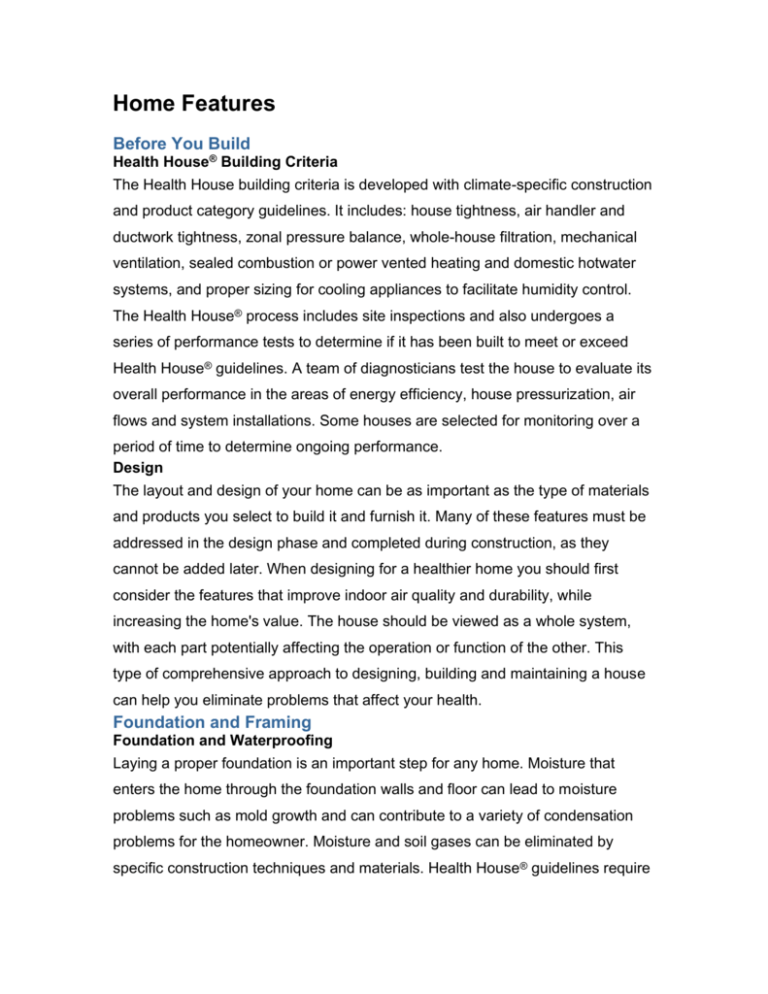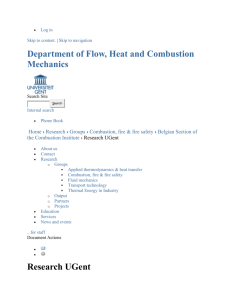
Home Features
Before You Build
Health House® Building Criteria
The Health House building criteria is developed with climate-specific construction
and product category guidelines. It includes: house tightness, air handler and
ductwork tightness, zonal pressure balance, whole-house filtration, mechanical
ventilation, sealed combustion or power vented heating and domestic hotwater
systems, and proper sizing for cooling appliances to facilitate humidity control.
The Health House® process includes site inspections and also undergoes a
series of performance tests to determine if it has been built to meet or exceed
Health House® guidelines. A team of diagnosticians test the house to evaluate its
overall performance in the areas of energy efficiency, house pressurization, air
flows and system installations. Some houses are selected for monitoring over a
period of time to determine ongoing performance.
Design
The layout and design of your home can be as important as the type of materials
and products you select to build it and furnish it. Many of these features must be
addressed in the design phase and completed during construction, as they
cannot be added later. When designing for a healthier home you should first
consider the features that improve indoor air quality and durability, while
increasing the home's value. The house should be viewed as a whole system,
with each part potentially affecting the operation or function of the other. This
type of comprehensive approach to designing, building and maintaining a house
can help you eliminate problems that affect your health.
Foundation and Framing
Foundation and Waterproofing
Laying a proper foundation is an important step for any home. Moisture that
enters the home through the foundation walls and floor can lead to moisture
problems such as mold growth and can contribute to a variety of condensation
problems for the homeowner. Moisture and soil gases can be eliminated by
specific construction techniques and materials. Health House® guidelines require
special mastic coating and drain board to be applied to the exterior of the
foundation wall. At the foundation footing, drain tile is installed so that the water
will run down the drainboard and drain away from the house. Capillary breaks are
used below the slab and footing to isolate porous products from liquid water.
Framing
There are a variety of framing materials and systems available in today's building
industry. Framing is an important component because it must be done in a way
that supports the house, protects against the elements and contributes to the
structure's thermal efficiency. A good framing system is one that allows for a
higher insulation value to improve thermal efficiency, reduces wood waste (if
wood is used) and provides long term protection to a home's structural integrity.
Heating, Ventilation, Cooling and Dehumidification Systems
Installation
When sizing and installing the heating, ventilation, and cooling (HVAC)
equipment, it is important to work with contractors who have a good
understanding of the mechanical systems and their interaction with other
appliances in the home.
Geothermal Heating System
Over three times more efficient than high efficiency natural gas or propane
furnaces, geothermal heating uses the earth's natural renewable resources to
heat, cool and supply domestic hot water. Geothermal technology is a basic heat
transfer system that collects or rejects (depending on the time of year) heat from
a piping system buried in the ground. Because the earth is a constant
temperature between 45-55°F, a geothermal system can economically provide
heat energy in cold weather, and cooling energy in warm weather. There is also
an equipment option to supply hot water to the water heater, eliminating the need
to burn fossil fuels on site.
Sealed Combustion Appliances
Health House® guidelines require all fuel-burning equipment use sealed
combustion, meaning it has its own air supply directly vented into the appliance
for combustion, and a vent for exhausting the combustion gases to the exterior of
the home. Sealed combustion appliances eliminate the threat of harmful
combustion by-products from entering the home via the heating and cooling
equipment vents.
Combustion Safety
Health House® guidelines also call for non-combustion or sealed combustion
appliances and direct vent sealed gas fireplaces. Recent studies have shown
that carbon monoxide, sometimes produced in significant levels when
automobiles are started, can enter the home from the attached garage. For this
reason the Health House® guidelines require that carbon monoxide detectors be
installed in all homes.
Ventilator
Ventilation acts as the lungs for the home by providing a continuous supply of
fresh, filtered air, while exhausting the stale, contaminated air. A good, whole
house mechanical ventilation system with source point ventilation is needed in
kitchens, bathrooms and laundry rooms to exhaust the water vapors and odors
out of the house. If needed, the homeowner can ‘surge' the system with a push of
a button to increase the ventilation rate. Health House® guidelines require a
complete change of air in the home.
Range Hoods
Cooking produces odors, water vapor and particulates such as grease and
smoke. These should be captured and removed from the interior of the house to
prevent airborne contamination. In regard to kitchen exhaust range hoods, bigger
is not always better. Range hoods should be carefully sized and installed so that
they have their own make-up or replacement air for safe operation.
Ductwork
It is important to have tightly sealed ductwork in your house. This will prevent air
leakage and also will prevent contaminants from entering the ductwork and
circulating through the home. This is achieved by carefully air sealing all duct
seams with mastic and mesh. Air-sealing of ductwork also helps to balance the
pressure of airflow through the ducts, preventing negative or positive pressure
situations in the house that can lead to other problems. In addition, all cold air
returns should be ducted to prevent contamination.
Duct Cleaning
During the construction process much debris and building scraps often end up in
the ducts through the registers. Unless removed, fine particles from the debris,
which can be respiratory irritants, can circulate within the ducts and enter a room
through the registers. In the final stage of building a home, prior to moving in, the
ducts should be cleaned and vacuumed to remove any particles that may have
entered during construction.
Direct Vent Fireplace
Health House® guidelines call for a sealed combustion gas fireplace to eliminate
the threat of harmful combustion gases from entering the house. All fuel burning
fireplaces should have sealed combustion and be properly vented to the outside.
If not properly vented and sealed, the fireplace can produce harmful combustion
pollutants which may be emitted into the home (carbon monoxide, nitrogen
dioxide and sulfur dioxide).
High Efficiency Air Filtration Systems
Filtering the air is key to removing airborne contaminants and to keeping the air
handling system clean. The higher the efficiency, the better the filtration system
is at capturing and removing small particles from the air. Minimum requirements
for Health House® guidelines are to install a filter with a MERV rating of 10. A
HEPA (High Efficiency Particle Arrestant) Filtration System is 99.97% efficient at
removing particles 0.03 microns in size. Because of its high efficiency at filtering
out tiny particulates, HEPA filtration is recommended for those individuals who
suffer from allergies, asthma or other respiratory problems. The filtration system
connects in-line with the furnace ductwork and offers three stage filtration. An
anti-microbial polyester pre-filter with a five pound, activated carbon filter is
attached to the filtration system.
Dehumidification System
The Health House® guidelines require that the relative humidity (RH), levels in
the houses be maintained at 35-55%. Depending on climate and time of year,
this could require either demumidification or humidification. Elevated levels of
humidity, in heating or cooling seasons, can provide an ideal environment for
mold growth and dust mites, and can lead to structural degradation. A whole
house dehumidification system can help maintain the RH level within this target
zone during cooling seasons.
Central Vacuum
Central vacuum systems provide cleaner indoor air by efficiently removing
particles without stirring up microscopic dust particles and re-emitting them into
the interior of the home. The central vacuum receptacle is vented outside of the
living space keeping the air inside free of the pollutants.
Air Sealing and Insulation
Insulation
The Health House® guidelines for insulation, some of the most stringent in the
building industry, are designed to ensure maximum thermal performance and
occupant comfort. A house should be well insulated, using materials that provide
good coverage within wall cavities, attics and at the foundation. Insulation also
can help to eliminate interior condensation problems within the walls by keeping
cool air and warm air from meeting in the wall and condensing into water vapor
that can contribute to mold growth. Insulation used within the home’s interior
walls can provide good acoustical control and may be exceptionally helpful for
reducing sound between the living and sleeping areas of the home.
Air/Vapor Retarder
A home built to the Health House® guidelines is constructed airtight to improve
energy efficiency and prevent unplanned moisture movement. Moisture can be a
great problem to the health of you and your house. Sealing the air/vapor retarder
seams, electrical outlets and wiring runs and using foam in window and door
rough openings will reduce air infiltration by an additional 30%.
Windows and Lighting
Lighting
Even when covered with insulation, standard recessed lighting fixtures still allow
significant amounts of conditioned air to escape (exfiltration) and unconditioned
air to enter (infiltration) through fixture’s perforations and space between the
fixture and the ceiling opening. By using recessed lighting fixtures that have no
perforations and a foil gasket to seal between the recessed housing and the
ceiling, air leakage is essentially eliminated, preventing energy loss and moisture
condensation. In addition, energy efficiency can be improved by selecting lowwattage bulbs, such as halogen or fluorescent, that last up to four times longer
than incandescent bulbs.
Windows
High efficiency windows with low-E (low emissivity) can provide a beautiful view
while saving you money through greater energy efficiency. Quality windows also
provide design options for noise reduction, high resistance to condensation, and
protection from UV rays that can damage and fade furnishings. Strategically
positioning the windows in your home (i.e. placement, sizing and direction) can
help you maximize the use of natural light from the sun and sky. This is called
daylighting. The benefits from daylighting are greater energy efficiency and lower
energy bills, as well as positive effects on your mental and physical well-being.
Finishes and Furnishings
Interior Design
We spend most of our time indoors and much of this is in our homes. How we
finish and furnish our homes can impact the quality of our indoor environment.
Selecting materials for the interior of your home can be a challenge if you are
sensitive to the many chemicals often used in their production and preservation.
Manufacturers should be able to provide you with a Material Safety Data Sheet
on their product before you buy. Consider selecting products that are
environmentally friendly and healthy and are low in volatile organic compounds
(VOCs). Pay attention to products such as vinyl wallpaper, treated fabrics and
flooring that may give off chemical emissions into your home. When decorating
for a healthier environment, use space efficiently and minimize or eliminate
surfaces that can attract and collect dust. As you furnish your home, try to avoid
furniture made from particleboard. Some particleboard contains urea
formaldehyde, commonly used as a bonding agent, and can off-gas in the home
causing irritation to the occupant. If you do purchase furniture that contains
particleboard, consider sealing it with a no or low VOC sealant.
Paint
All paints release trace amounts of gases for months following application which
may cause upper respiratory irritation to the occupants. For this reason, selecting
a no or low VOC paint can reduce the amount of chemical emissions introduced
into the house environment.
Smooth Surface Floors
The choice for the healthiest homes; smooth surfaces, such as tile, linoleum and
wood, do not harbor dust and other allergy-causing particles like thicker, denser
floor coverings. Solid surfaces are easier to clean than carpet and they keep
vacuuming to a minimum. Vacuuming stirs up dust, even under ideal conditions.
For resource efficiency, consider installing hardwood harvested from a
sustainable source, or look for wood flooring that has been salvaged from an old
building or home. Many times, the wood is sold re-sawn and ready to use.
Carpet
Minimum use of carpet is permitted in the Health House® guidelines for comfort
and aesthetic reasons. If carpet is used, a central vacuum system is a
requirement. New carpet can emit volatile organic compounds (VOCs) when first
installed. For this reason it is recommended that you purchase your carpet well in
advance of the installation. Unroll the carpet in a well ventilated area for at least
24 hours to allow it to "off-gas" the VOCs. Once installed, it must be vacuumed
frequently as it becomes a collector of dust mites and other allergens. If you do
select carpet for your home, choose low pile, and install it with urethane padding.
Also, carpet should never be applied to a concrete slab unless provisions for a
moisture/vapor retarder or insulation have been incorporated in the slab that will
allow the carpet to remain warm and dry.
Carpet products can be used if they meet the following criteria:
Carpet Rug Institute (CRI) IAQ label
No wall-to-wall carpet in bathrooms, kitchens, utility rooms, basements or
entryways
Use 100% nylon yarn system, or polyester or wool pile
Greater than or equal to 100 stitches/sq. in.
Gauge: 12 or higher
Nap height: less than 0.5 inch
Installation
Use tack strips to lay down carpet (no glues); OR, factory supplied non-wet, low
VOC adhesive
Permanent chemically welded seams
Particleboard underlayment or other urea-formaldehyde wood products are not to
be used under carpets
If a carpet product with any type of vinyl backing is laid over concrete, the slab
must be tested to ensure that the moisture content and the alkalinity of the
concrete meets the product manufacturer's specifications (NOTE: this applies to
any flooring applied to concrete)
If carpet is installed, a central vacuum system must be installed and vented to the
outdoors (the system can be exhausted to home interior if the air is HEPA filtered)
Low Flow Plumbing
Low-flow plumbing works to conserve our precious fresh water resources. These
fixtures reduce the overuse of natural resources and subsequent treatment and
disposal.
Cabinetry
The best selection for cabinets is solid hardwood, finished with a low VOC
product to avoid problems from formaldehyde and other VOC emissions. Many
cabinets are made from particleboard that has a wood veneer finish glued to it.
The particleboard and the glue may contain formaldehyde and other VOCs, that
when off-gassed or emitted can be an irritant to many people. Another option is
metal cabinetry because of its inert qualities. If using cabinets with particleboard,
they should be sealed with a water-based, or low VOC sealant.
Household Pollution Prevention
Household Products
Household cleaning agents, personal care products, pesticides, paints, hobby
products, cleaners and solvents that make our lives so easy are also sources of
hundreds of potentially harmful chemicals. Consider nontoxic alternatives, buy
only the quantity you need, store or dispose of hazardous products carefully,
always read the product label and follow manufacturer's instructions. If you
choose to use toxic products, do so in a well ventilated area to minimize your
exposure to the product's vapors.
Healthy Home Alert | Home Pollutants | Home Features
Tip Sheets | Indoor Air Quality Checklist
American Lung Association Health House® Program
490 Concordia Avenue, St. Paul, MN, 55103-2441
(877) 521-1791, (800) LUNG-USA within MN, Fax (651) 281-0242
www.healthhouse.org • info@alamn.org
© 1997-2004 American Lung Association of Minnesota. All Rights Reserved.
Terms of Use
Site host donated by Clientek.






